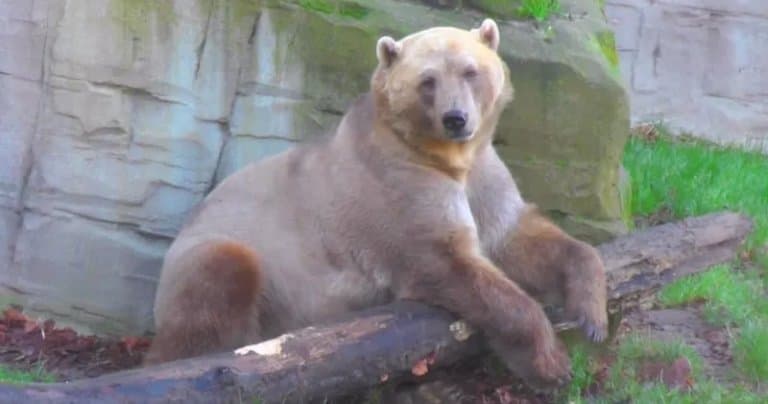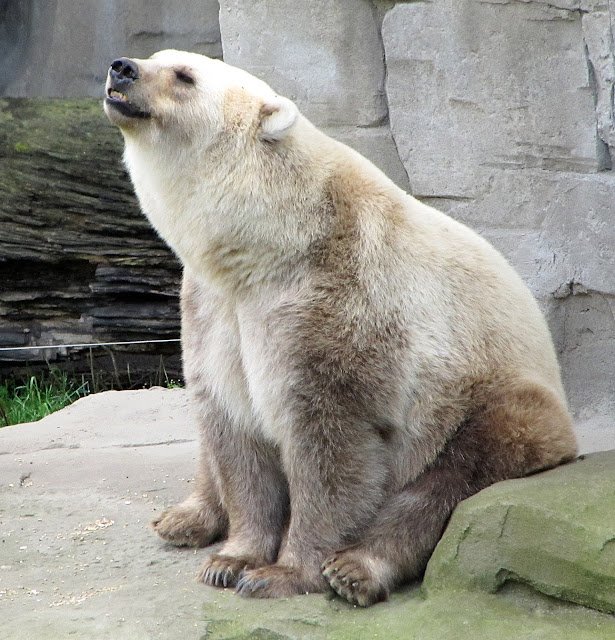Grolar Bear Profile
Sometimes when you reach max level, you stop levelling. In the case of the polar bear, the status of largest land predator, “hypercarnivore”, and apex predator wasn’t enough.
They needed to take things one step further and team up with the most iconic and terrifying animal in North America; an animal so scary its scientific name is horribilis.
Usually, it’s a bad idea for cousins to reproduce, but try telling this to the Grolar bear: a lovechild of the two most fearsome mammals on land, a polar bear and grizzly bear.
This grizzly–polar bear hybrid also goes by other names, including ‘pizzly bear’ or ‘zebra bear’.

Grolar Bear Facts Overview
| Habitat: | Cold, terrestrial |
| Location: | Arctic, Northern regions of North America |
| Lifespan: | Approx. 25 years |
| Size: | Smaller than 1.5 m |
| Weight: | 300 – 500 kg (660 – 1,100 lb) |
| Color: | Blonde, light brown |
| Diet: | Large mammals (caribou and bison), seals, reindeer, carrion, fish, berries, clams |
| Predators: | None |
| Top Speed: | 40 kph / 25 mph |
| No. of Species: |
Not defined |
| Conservation Status: |
Not listed |
As the polar regions get warmer, brown bears can tolerate higher latitudes. Conversely, the shrinking habitat of polar bears is creating a refugee crisis as the great beasts descend to lower latitudes in search of new territories.
This increasing overlap in habitats between grizzlies and polar bears is becoming an interesting venue for the romantic entanglements of two distinct species; the product of which may be nature’s way of keeping the genes of both alive in a rapidly-changing environment.
In 2006 the first wild evidence of a grolar bear hybrid was confirmed with DNA testing. Subsequently the number of confirmed hybrids in the wild is thought to be around 8, although others have also been reported, yet not confirmed.
They physical traits of hybrids appear to be generally intermediate between their parents. Hybrids tend to have smaller bodies than polar bears, but larger than grizzlies. They can have creamy fur typical of polar bears, but with a humped back, long claws and brown patches around its eyes and feet, which are more typical of grizzly bears.
Like both parents, grolar bears are opportunistic apex predators that are capable of hunting large prey and diet largely on meat. Their strong front legs are adapted both for running fast to catch prey, and have a streamlined body that allow them to swim in cold waters.
Interesting Grolar Bear Facts
1. Fertile Pizzly bears
Pizzly is a much less intimidating than some of the other names for the hybrid, to the point where it might be considered a slur. Still, these names reflect a frightening reality: a polar bear was able to mate with a grizzly bear.
But more importantly, the offspring are fertile. Commonly, hybrids are sterile offspring of two different species from the same genus.
Horses and donkeys can mate, and they can produce offspring, but that’s the end of the line: there’s not enough similarity in their chromosomes to produce offspring that can continue the process.
Grolar bears, on the other hand, come from two species only recently separated, and their chromosomes match up. This suggests that offspring are likely capable of reproducing; something which has been confirmed in captive examples. So, why aren’t there more of them? 1

2. Swings and roundabouts
Hybridisation comes with a lot of opportunity cost, and often not a lot of opportunity. Usually, hybrid offspring are less suited to their environments than either one or the other parent species would be.
In Grolar bears, the resulting abomination is smaller than a polar bear, has a longer snout, and isn’t more comfortable eating plants. All of these may act as an advantage over polar bear species in a changing landscape where sea ice is retreating and animal protein is becoming scarce.
The major reason these occur so rarely in the wild is the lack of overlapping habitats. However, with climate change, this overlap is becoming more common as polar bears move farther South to find more land.
3. This could be a great example of speciation
Evolution doesn’t happen linearly. Mutations arise at random, most of which are either benign or disadvantageous, and they either lie dormant or cause so much harm to the organism’s fitness that they are removed from the gene pool.
Evolution often happens in leaps, usually when an environmental change takes place and a latent mutation suddenly becomes an advantage. With man-made climate change destroying the polar ice caps, polar bear habitats are decreasing faster than polar bear mutations could ever compensate for.
This hybridisation, as a result of newly-overlapping bear habitats, may result in the continuation of a new lineage of bear genes; one that’s more suited to the new environment.
If Grolar bears succeed in occupying and dominating new habitats, they may eventually be classified as a unique species.
4. But, some think this is unlikely
As mentioned, hybrids are not usually well-equipped, and the genetic traits they inherit generally come at a disadvantage to them.
Some researchers suggest that Grolar bears’ colouration, dentition and other aspects of their physiology make them poorly adapted to both terrestrial and marine habitats.
While this may be true in the stable, predictable environment of the last ten thousand years, recent environmental shifts bring new challenges to organisms, and should the particular physiological makeup of the Grolar suddenly become more suited to these new challenges than either of its parent species, we may end up seeing more of them. 2

5. Historically, hypercarnivores are vulnerable
The polar bear, being an obligate hypercarnivore, needs to eat high-calorie, animal-based food to sustain itself. These specialist predators are good at what they do, as long as the circumstances don’t change.
On the other hand, when the environment changes, it’s generalists who do well.
Dogs, pigs, rats, and humans are all successful due to the fact that they can eat pretty much anything, and this has allowed them to weather ice ages and warm periods that have taken out such glamourous beasts like the sabre-toothed tiger and the American cheetah.
And so it is with the polar bear. Which lends even more credence to the idea that the Grolar may be an evolutionary compromise to a new environment. 3
6. They can be produced in large numbers!
While the reproductive rates of the Grolar are still uncertain (since they’re still so rare), at least one example of a female polar bear has shown that they can be manufactured quickly in an emergency.
This female produced four Grolar cubs, some of which reproduced with more grizzly bears to produce four more.
These offspring would have been back-crossed, reintroducing more grizzly genes into a grolar hybrid, which further confuses the matter, but researchers were able to trace eight hybrids back to a single female polar bear who mated with two grizzlies. 4
7. Those discovered in the wild are ‘grolar bears’
Generally the naming convention means the name of the sire comes first. So the offspring of a male grizzly bear and a female polar bear like those discovered in the wild is ‘grolar bear’.
The offspring of a male polar bear and a female grizzly would be a ‘pizzly bear’, and none of these hybrids have been confirmed yet in the wild.
Officials in Canada have proposed naming the hybrid “nanulak,” a combination of the Inuit names for polar bear (‘nanuk’) and grizzly bear (‘aklak’).
8. Hybridisation is not a widespread solution to biodiversity loss
While the Grolar bear might succeed in adapting to a sudden change in its environment, there’s no guarantee that it will. Many researchers still expect the hybrid to remain rare, and not to replace pure-bred populations in any meaningful way.
However, even if it does, this is an exceptionally uncommon event. Most hybrids fail to thrive unequivocally, and almost all are incapable of producing viable offspring.
Still, the Grolar bear represents a new and exciting branch of zoology and promises to change the way we think about adaptations, even among some of our most familiar and iconic animals. 5
9. Hybrids have been born in captivity
A grizzly bear and a polar bear shared an enclosure for 24 years without anything happening. That is until the female grizzly gave birth to two hybrid cubs in 2004.
The two hybrid grolar bears that were born were kept in captivity at Osnabrück Zoo in Germany. Sadly, the female hybrid bear known as ‘Tips’ escaped her enclosure in 2017 and was shot dead.
Grolar Bear Fact-File Summary
Scientific Classification
| Kingdom: | Animalia |
| Phylum: | Chordata |
| Class: | Mammalia |
| Order: | Carnivora |
| Family: | Ursidae |
| Genus: | Ursus |
| Species Name: |
Ursus Arctos ♂ × Ursus Maritimus ♀ |
Fact Sources & References
- CHRISTINE CLISSET (2020), “Pizzly Bears“, Slate.
- Dr. Evan Richardson (2021), “Pizzlies? Grolars? Why Hybrids Aren’t an Answer for Polar Bears“, Polar Bears International.
- Ben Turner (2021), “‘Pizzly’ bear hybrids are spreading across the Arctic thanks to climate change“, Live Science.
- Jodie D. Pongracz et al (2017), “Recent Hybridization between a Polar Bear and Grizzly Bears in the Canadian Arctic“, Arctic.
- “Science Blender: Biodiversity, Pizzly Bears and Grolar Bears“, Chapman University.
